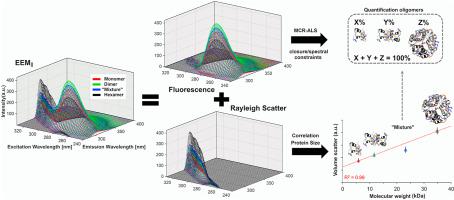当前位置:
X-MOL 学术
›
Anal. Chim. Acta
›
论文详情
Our official English website, www.x-mol.net, welcomes your feedback! (Note: you will need to create a separate account there.)
Quantitative analysis of weakly bound insulin oligomers in solution using polarized multidimensional fluorescence spectroscopy
Analytica Chimica Acta ( IF 6.2 ) Pub Date : 2020-11-01 , DOI: 10.1016/j.aca.2020.09.007 Yannick Casamayou-Boucau , Alan G. Ryder
Analytica Chimica Acta ( IF 6.2 ) Pub Date : 2020-11-01 , DOI: 10.1016/j.aca.2020.09.007 Yannick Casamayou-Boucau , Alan G. Ryder

|
Being able to measure the size and distribution of oligomers in solution is a critical issue in the manufacture and stability of insulin and other protein formulations. Measuring oligomers reliably can however be complicated, due to their fragile self-assembled structures, which are held together by weak forces. This can cause issues in chromatographic based methods, where dissociation or re-equilibration of oligomer populations can occur e.g. upon dilution in a different eluting buffer, but also for light scattering based methods like dynamic light scattering (DLS) where the size difference involved (often less than a factor 3) does not allow mixtures of oligomers to be resolved. Intrinsic fluorescence offers an attractive alternative as it is non-invasive, sensitive but also because it contains scattered light when implemented via excitation emission matrix (EEM) measurements, that is sensitive to changes in particle size. Here, using insulin at formulation level concentrations, we show for the first time how EEM can both discriminate and quantify the proportion of oligomeric states in solution. This was achieved by using the Rayleigh scatter (RS) band and the fluorescence signal contained in EEM. After validating size changes with DLS, we show in particular how the volume under the RS band correlated linearly with protein/oligomer molecular weight, in agreement with the Debye-Zimm relationship. This was true for the RS data from both EEM and polarized EEM (pEEM) measurements, the latter providing a stronger scatter signal, more sensitive to particle size changes. The fluorescence signal was then used with multivariate curve resolution (MCR) to quantify more precisely the soluble oligomer composition of insulin solutions. In conditions that promoted the formation of mainly one type of oligomer (monomer, dimer, or hexamer), pEEM-MCR helped identify the presence of small amounts of other oligomeric forms, while in conditions that were previously said to favour the insulin tetramer, we show that in the presence of zinc, these insulin samples were instead a heterogenous mixture composed of mostly dimers and hexamers. These MCR results correlated in all cases with the observed discrimination by principal component analysis (PCA), and deviations observed in the RS data. In conclusion, using pEEM scatter and emission components with chemometric data analysis provides a unique analytical method for characterising and monitoring changes in the soluble oligomeric state of proteins.
中文翻译:

使用偏振多维荧光光谱法定量分析溶液中弱结合的胰岛素低聚物
能够测量溶液中低聚物的大小和分布是胰岛素和其他蛋白质制剂制造和稳定性的关键问题。然而,可靠地测量低聚物可能很复杂,因为它们易碎的自组装结构通过弱力保持在一起。这可能会导致基于色谱的方法出现问题,其中可能发生寡聚体群体的解离或重新平衡,例如在不同的洗脱缓冲液中稀释时,但对于基于光散射的方法,如动态光散射 (DLS),其中涉及大小差异(通常小于因子 3) 则无法解析低聚物的混合物。本征荧光提供了一种有吸引力的替代方案,因为它是非侵入性的,敏感,但也因为它在通过激发发射矩阵 (EEM) 测量实施时包含散射光,这对颗粒尺寸的变化很敏感。在这里,我们使用制剂浓度的胰岛素,首次展示了 EEM 如何区分和量化溶液中寡聚态的比例。这是通过使用瑞利散射 (RS) 带和 EEM 中包含的荧光信号实现的。在使用 DLS 验证大小变化后,我们特别展示了 RS 带下的体积如何与蛋白质/寡聚体分子量线性相关,与 Debye-Zimm 关系一致。这对于来自 EEM 和极化 EEM (pEEM) 测量的 RS 数据都是正确的,后者提供更强的散射信号,对粒度变化更敏感。然后将荧光信号与多变量曲线分辨率 (MCR) 一起使用,以更精确地量化胰岛素溶液的可溶性低聚物组成。在主要促进一种寡聚体(单体、二聚体或六聚体)形成的条件下,pEEM-MCR 有助于识别少量其他寡聚体形式的存在,而在之前据说有利于胰岛素四聚体的条件下,我们表明在锌存在的情况下,这些胰岛素样品是主要由二聚体和六聚体组成的异质混合物。这些 MCR 结果在所有情况下都与通过主成分分析 (PCA) 观察到的区别以及在 RS 数据中观察到的偏差相关。综上所述,
更新日期:2020-11-01
中文翻译:

使用偏振多维荧光光谱法定量分析溶液中弱结合的胰岛素低聚物
能够测量溶液中低聚物的大小和分布是胰岛素和其他蛋白质制剂制造和稳定性的关键问题。然而,可靠地测量低聚物可能很复杂,因为它们易碎的自组装结构通过弱力保持在一起。这可能会导致基于色谱的方法出现问题,其中可能发生寡聚体群体的解离或重新平衡,例如在不同的洗脱缓冲液中稀释时,但对于基于光散射的方法,如动态光散射 (DLS),其中涉及大小差异(通常小于因子 3) 则无法解析低聚物的混合物。本征荧光提供了一种有吸引力的替代方案,因为它是非侵入性的,敏感,但也因为它在通过激发发射矩阵 (EEM) 测量实施时包含散射光,这对颗粒尺寸的变化很敏感。在这里,我们使用制剂浓度的胰岛素,首次展示了 EEM 如何区分和量化溶液中寡聚态的比例。这是通过使用瑞利散射 (RS) 带和 EEM 中包含的荧光信号实现的。在使用 DLS 验证大小变化后,我们特别展示了 RS 带下的体积如何与蛋白质/寡聚体分子量线性相关,与 Debye-Zimm 关系一致。这对于来自 EEM 和极化 EEM (pEEM) 测量的 RS 数据都是正确的,后者提供更强的散射信号,对粒度变化更敏感。然后将荧光信号与多变量曲线分辨率 (MCR) 一起使用,以更精确地量化胰岛素溶液的可溶性低聚物组成。在主要促进一种寡聚体(单体、二聚体或六聚体)形成的条件下,pEEM-MCR 有助于识别少量其他寡聚体形式的存在,而在之前据说有利于胰岛素四聚体的条件下,我们表明在锌存在的情况下,这些胰岛素样品是主要由二聚体和六聚体组成的异质混合物。这些 MCR 结果在所有情况下都与通过主成分分析 (PCA) 观察到的区别以及在 RS 数据中观察到的偏差相关。综上所述,


























 京公网安备 11010802027423号
京公网安备 11010802027423号